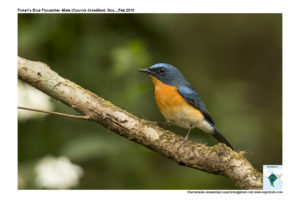Tickells-blue Flycatcher

Tickell’s Blue Flycatcher Cyornis tickelliae
Etymology:
- Cyornis : Greek Word kuanos dark-blue; ornis
- Tickelliae : Named after British ornithologist Samuel Richard Tickell (1811–1875)
Vernacular Names: Guj: Adharanga, Mar: Nilima, Tickelchi Nili Mashimar Ta: Kopi kuruvi, Neelakkuruvi, Kan: Neeli rajapakshi, Sinh: Kopi-kurulla, Marawa
Distribution in India: Resident of parts of Gujarat, Central and Peninsular India.
Description:Size of 13-14 cm, wt. of 12-18 g. It is a medium-sized blue or paler blue-grey flycatcher with orange and white underparts. Male nominate race has upper forehead to over eye azure-blue, lower forehead to cheek, lower ear-coverts and chin blackish-blue; rest of head and upperparts, including upperwing and tail, cerulean-blue, lesser coverts also bright blue forming “shoulder patch”; center of lower throat to upper breast orange-rufous, often rather sharply demarcated from white of belly, flanks and undertail-coverts, but sometimes an orange wash on flanks; iris brown; bill black; legs bluish-brown to violet-grey, pink or pinkish-brown. Female is paler than male, paler blue or ash-grey above, or slightly bluer on rump and tail and brighter blue on upper forehead to eye and shoulder patch, has pale orange across upper lores to partial eyering, and orange below paler and often confined to a wash on breast and flanks. The juvenile is dark brown above, with small buffish speckles or streaks on crown, larger spots on mantle and scapulars, wings and tail are as adult but with pale buff tips to median and greater wing-coverts, face is finely streaked or mottled brown and buffish, narrow buff eyering, lores and chin are pale buff, becoming barred faintly with warm brown on breast, buffish on lower breast and flanks, and whitish to undertail-coverts.
Habitat: It is found in lowland and submontane open dry woodlands and forest, including secondary forest, edges, groves, abandoned plantations, edges of cultivation, villages and large wooded gardens, bamboo, scrub and bushes along streams.
Food Habits: It eats small invertebrates and larvae. It is usually solitary or in pairs; occasionally in mixed-species flocks in dry woodland. It actively forages in lower to middle levels of forest, also in undergrowth along banks of streams and around bushes; often most active at dawn and towards dusk. Most prey items are taken by hawking or by pursuit in sallying flight; occasionally hovers to pick item from foliage. It perches upright; flicks tail, often simultaneously giving sharp call.
Breeding Habits: They breeds in Apr-Aug in India. The displaying male leans sideways and raises crest and back feathers while vibrating them, also partially fans and spreads tail. The nest is an open cup, loosely constructed, mostly of moss, grass, plant fibers, and bamboo and other leaves, placed in crevice in rocky wall, between boulders, in tree trunk or among roots of upturned tree. It lays a clutch of 3–4 eggs and both parents tend nestlings.